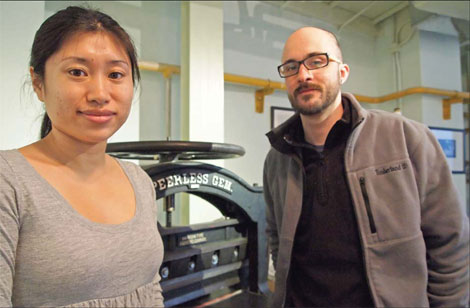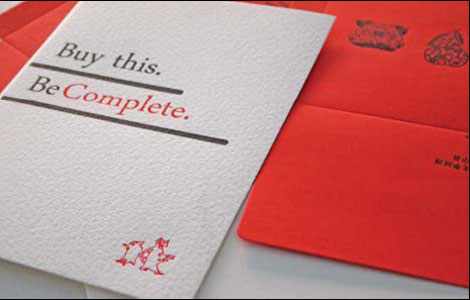The press gang
Updated: 2012-02-10 09:36
By Zhang Lei (China Daily)
|
||||||||
|
Li Cong and her husband Josh Durham run a letterpress shop in Beijing. [Photos by Liu Xiaozhuo / China Daily] |
Couple do their bit to breathe life into dying printing craft
They sit in a shop in an alley behind East Gongti Road in Beijing, two bulky machines that seem to belong more to a museum or an art gallery. But for Josh Durham, an American history teacher, the movable letterpress machines could not have found a better home.
"I wanted somewhere with a window where people could see me work," says Durham, 32. "Not many people in China know what a letterpress is now. I thought it was very important to see a funny little laowai (foreigner) using it."
Amid the modern computer age that threatens the very existence of the letterpress, Durham brought his two machines to the country that helped develop the art of using them during the Song Dynasty almost 1,000 years ago.
Durham's two-story Paper Pounder Press studio opened for business in July. His two letterpresses "Jenny" and "Pearl", which date back to the beginning of the 20th century are in a corner on the first floor. An exquisite "peerless gem" paper cutter, also more than a century old, stands quietly near the reception desk, on which are stacked letterpress-made birthday and name cards as well as wedding invitations, postcards and posters.
Durham's wife Li Cong came up with the idea of starting the letterpress business, and Durham was instantly drawn to it.
"She has a thousand passions. She is the dreamer and I agreed with starting working on it," he says. "What drew me to the letterpress in the first place was the pace of the work. It is slow and it allows me to create something new. It is a step back in time. I studied history so I am drawn to the history of these machines."
Durham also studied Daoism and Buddhism in the United States. He visited Yunnan province as a student for five weeks in 2002. He loved it and met his wife in a ceramics class before marrying her in the US. While he was teaching, he thought about what they should do in China.
"When my wife came up with the idea, I studied everything I could about the letterpress in the US. I went for an apprenticeship in a letterpress shop where I learned the basics of the technique."
Durham used the Internet to find letterpresses for sale and traveled around the US to find them. The couple lived in Louisville, Kentucky. Jenny was obtained in a garage in Cleveland Ohio, while Pearl was found in Boston, Massachusetts. Durham brought the machines back, boxed them and shipped them to China.
"The presses that I print on are both more than 100 years old. They are the exact opposite of everything that society is going for right now - 'faster and cheaper'," Durham says. "I like things being hand crafted. If it is worth printing, it is worth printing slowly and beautifully. I am just drawn to the whole idea of the letterpress."
Still, there is one critical "technological upgrade" that makes the old art of the letterpress available once again. Instead of an old wooden board engraving or the copperplate, photosensitive polymer plates designed from computers using flexography techniques free the craftsmen from making heavy metal plates, especially in the case of using Chinese characters and high-demand art designs.
"Metal type blocks cost too much and very few people can afford them. Considering the small business we have been running, photo polymers are more flexible and cost-effective. Any design can be done through it," says Li.
Most of their works are done on Jenny, a Golding 1909 letterpress. It was formerly a treadle-driven handcrafted piece but was later refitted with a motor that requires hand wheeling.
But Pearl is the real antique, the owners say. It is a smaller press, does not push the paper that hard and the quality of its products is harder to control. It was made in 1882 with the original treadle. Most of the time it just stands in the corner of the shop "retelling history".
Customers now ask Zuo Zuo, the graphic designer, to come up with the patterns they want on the computer. The patterns are then developed on a flexographic press machine and the rest of the work is left to Durham. He splashes ink on the plates, before pressing the hand bar on the letterpress machine.
The letterpress is now his way of life.
"After college, I made T-shirts. It was a different kind of printing, of course, but I had a year of experience in printing and enjoyed it, with something to show at the end of the day. So letterpress printing makes sense to me," he says.
"It all goes against fast printing. I like the idea of the anti-modern capitalist approach, the idea that one man can make a living. It is not like a factory, making a whole bunch of stuff that sells real cheap. It is the whole idea of you yourself making something. It is the things that mattered before modern capitalism."
Durham and his wife, who have two children, do not do a lot of retail and are instead involved in more commissioned work. "We have wedding invitations, name cards. People come in and pay us to create art for them," he says.
Since letterpressing is hard work, prices are high. One hundred copies of single-color name cards are done for at least 888 yuan ($141, 108 euros). Extra colors can cost 700 yuan each for 100 copies. A5-size postal cards sell at 15 yuan a copy and posters go for 20 yuan a copy.
The business picked up a little at the beginning of October since weddings take place most frequently in the autumn, but Li says their business can barely cover their rent of nearly 30,000 yuan a month.
The couple plans to turn their second floor into a DIY experience center for their customers in the near future.
"Many customers are interested in making seals. I once invited a couple to do it themselves. It is not difficult for newly married couples, it is good for them to feel involved," Li says.
She adds that they might also buy a table-top letterpress so that customers can experience the old techniques themselves, as the current two handle-driven letterpresses are still dangerous for the unskilled.
"We will probably go back to the US when our children have to go to primary school, but I still hope the old art of the letterpress can be revived in China," she says.
|
Products created by the Paper Pounder Press. |

 Relief reaches isolated village
Relief reaches isolated village
 Rainfall poses new threats to quake-hit region
Rainfall poses new threats to quake-hit region
 Funerals begin for Boston bombing victims
Funerals begin for Boston bombing victims
 Quake takeaway from China's Air Force
Quake takeaway from China's Air Force
 Obama celebrates young inventors at science fair
Obama celebrates young inventors at science fair
 Earth Day marked around the world
Earth Day marked around the world
 Volunteer team helping students find sense of normalcy
Volunteer team helping students find sense of normalcy
 Ethnic groups quick to join rescue efforts
Ethnic groups quick to join rescue efforts
Most Viewed
Editor's Picks

|

|

|

|

|

|
Today's Top News
Chinese fleet drives out Japan's boats from Diaoyu
Health new priority for quake zone
Inspired by Guan, more Chinese pick up golf
Russia criticizes US reports on human rights
China, ROK criticize visits to shrine
Sino-US shared interests emphasized
China 'aims to share its dream with world'
Chinese president appoints 5 new ambassadors
US Weekly

|

|









